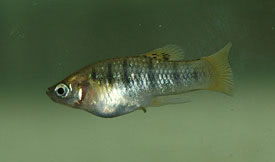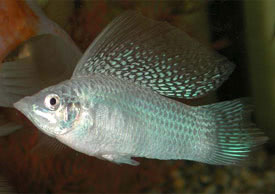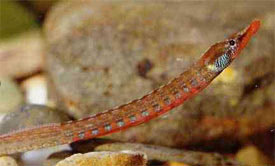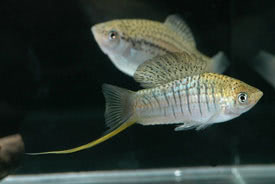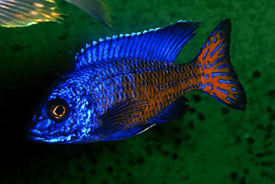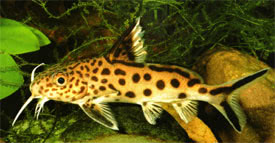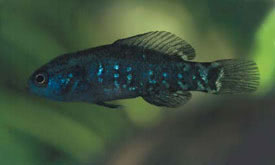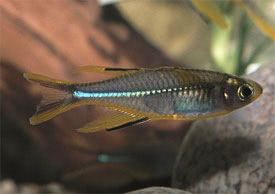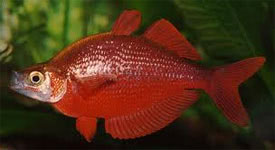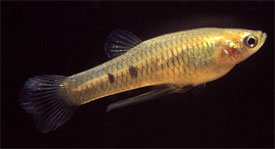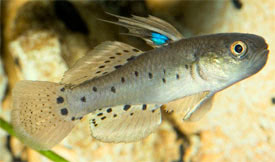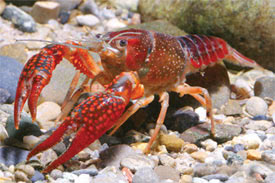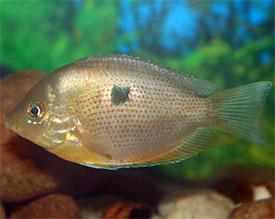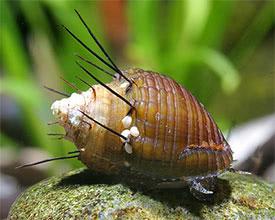Marisa cornuarietis - Giant ramshorn snail
 Magyarul / Hungarian
Magyarul / Hungarian

 Magyarul / Hungarian
Magyarul / Hungarian




- Scientific name: Marisa cornuarietis
- Synonyms: Ampullaria chiquitensis (d'Orbigny, 1838), Ampullaria knorrii (Philippi, 1852), Ampullaria rotula (Mousson, 1869), Ceratodes fasciatus (Guilding, 1828), Helix cornuarietis (Linnaeus, 1758), Planorbis contrarius (O. F. Müller, 1774)
- Common name: Giant ramshorn snail
- Group: Invertebrates
- Distribution: South America and Central America; Bolivia, Brazil, Colombia, Costa Rica, French Guiana, Guyana, Panama, Suriname, Trinidad and Tobago and Venezuela. It can be found in many other countries as an invasive species.
- Size: 3,5-5 cm
- Biotope: Found in lakes, rivers and swamps, where it lives in the shallow, slow-flowing areas with dense aquatic vegetation.
- Social behavior: Peaceful, can be kept with other species.
- Diet: Omnivorous; In nature they feed on decaying vegetation, dead fish, algae and aquatic plants. In the aquarium they accept any fish food and vegetables, but they also feed on aquarium plants, so they are not suited for planted aquariums.
- Breeding: Easy
- Tank: Minimum 40 litres
- Population: 4-5 snail for 75 litres
- Decoration: Larger stones, roots and densely planted aquarium.
- Temperature: 18-28 °C
- pH: 7.2-8.0
- Hardness: 10.0-25.0 dGH
- Lifespan: 2-3 years
Description: Although Marisa snails superficially resemble the great ramshorn snail (Planorbarius corneus) because of their shape of shells, they are not at all closely related, as they are member of the Apple Snail family. Marisa cornuarietis shell has about 3.5-4 spiral turns. The shell has a flat coiled shape with a width of 18-22 mm and a height of 48-56 mm. The color of their shell varies greatly: from dark yellow to dark brown tints with 3-6 black spiral stripes. There are color variants where the snail doesn't have any stripes at all. There are also species with complete yellow shell. The soft parts of the body can be colored white with a yellowish, gray and black pattern. The snail's upper side is often just beige with the bottom a darker brown color. Marisa cornuarietis are quite not demanding as for water parameters, they can live even in brackish water, however they will not breed under these conditions. In soft water that lacks of carbonates the snail's shell will start ruining. In addition they are very sensitive to water temperature decrese. This species has gills as well as a lung, to ensure efficient underwater respiration even in condition of low levels of dissolved oxygen.
Females have dark chocolate coloring of their leg, however males are light-beige with barely noticeable brownish spots.
A non-hermaphrodite snail. It lays eggs in characteristic disk-shape clutches below the waterline, in nature usually on the underside of aquatic plants' leaves, while in aquarium they can lay them on any surface. The eggs are about 2 to 3 mm in diameter. After about 2 weeks, the eggs become transparent, and the small snails appear.
Sources:
http://www.molluscabase.org/aphia.php?p=taxdetails&id=737469
http://meethepet.com/giant-ramshorn-snail-marisa-cornuarietis/
https://en.wikipedia.org/wiki/Marisa_cornuarietis
http://applesnail.net/content/species/marisa_cornuarietis.htm
http://www.molluscabase.org/aphia.php?p=taxdetails&id=737469
http://meethepet.com/giant-ramshorn-snail-marisa-cornuarietis/
https://en.wikipedia.org/wiki/Marisa_cornuarietis
http://applesnail.net/content/species/marisa_cornuarietis.htm
Hasonló vízparamétereket igénylő fajok






